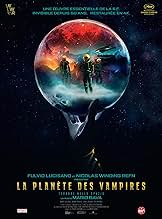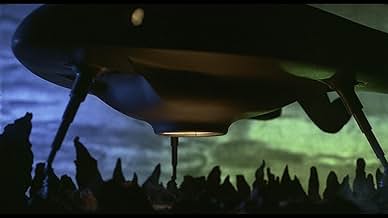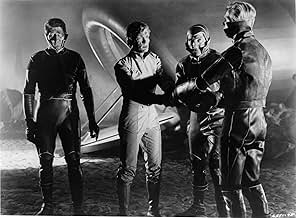IMDb-BEWERTUNG
6,2/10
7695
IHRE BEWERTUNG
Nach der Landung auf einem geheimnisvollen Planeten beginnt ein Team von Astronauten, sich gegeneinander zu wenden, beeinflusst durch den ungewissen Einfluss des Planeten und seiner seltsame... Alles lesenNach der Landung auf einem geheimnisvollen Planeten beginnt ein Team von Astronauten, sich gegeneinander zu wenden, beeinflusst durch den ungewissen Einfluss des Planeten und seiner seltsamen Bewohner.Nach der Landung auf einem geheimnisvollen Planeten beginnt ein Team von Astronauten, sich gegeneinander zu wenden, beeinflusst durch den ungewissen Einfluss des Planeten und seiner seltsamen Bewohner.
- Auszeichnungen
- 1 Nominierung insgesamt
Ángel Aranda
- Wess Wescant
- (as Angel Aranda)
Federico Boido
- Keir
- (as Rico Boido)
Vito Fasano
- Dead Galliott Crew Member
- (Nicht genannt)
Giuseppe Mattei
- Brent
- (Nicht genannt)
Empfohlene Bewertungen
This new release in the "MGM Midnight Movies" series of DVDs is an absolute must-have. The print of this 1965 classic is gorgeous, and for the first time since its theatrical release viewers can see the film in its original wide-screen format. For those who -- like me -- purchased the HBO Video version on VHS, don't worry: The original spare-but-effective electronic score has been restored, instead of the "updated" abomination that made the VHS print almost unwatchable.
Although I've never heard Dan O'Bannon acknowledge it, certain elements of this film must have been in his mind when he was working on "Alien": Two spaceships are drawn to an eerie, fog-shrouded planet by a mysterious radio signal, then snatched from orbit by an irresistible force. After crash landing, the surviving crew find themselves pitted against their own dead shipmates, resurrected by the parasitic mentalities of the planet, a dying race who must find a new home. There's even a scene where Barry Sullivan and Norma Bengell investigate an ancient, derelict alien spacecraft, complete with giant skeletons (any of this sound familiar?)
The set designs -- the cavernous interior of the spaceship and the appropriately alien fixtures of the derelict -- are some of the best you'll find in any pre-1968 science fiction film. Sullivan is suitably stoic as the warrior-scientist Captain; the supporting cast and in particular the luscious Ms. Bengell turn in remarkably understated performances, perfectly conveying dread verging on panic. While this movie may disappoint fans of director Mario Bava who are more familiar with his horror films, as a science fiction film buff I rate it a solid 7.
Although I've never heard Dan O'Bannon acknowledge it, certain elements of this film must have been in his mind when he was working on "Alien": Two spaceships are drawn to an eerie, fog-shrouded planet by a mysterious radio signal, then snatched from orbit by an irresistible force. After crash landing, the surviving crew find themselves pitted against their own dead shipmates, resurrected by the parasitic mentalities of the planet, a dying race who must find a new home. There's even a scene where Barry Sullivan and Norma Bengell investigate an ancient, derelict alien spacecraft, complete with giant skeletons (any of this sound familiar?)
The set designs -- the cavernous interior of the spaceship and the appropriately alien fixtures of the derelict -- are some of the best you'll find in any pre-1968 science fiction film. Sullivan is suitably stoic as the warrior-scientist Captain; the supporting cast and in particular the luscious Ms. Bengell turn in remarkably understated performances, perfectly conveying dread verging on panic. While this movie may disappoint fans of director Mario Bava who are more familiar with his horror films, as a science fiction film buff I rate it a solid 7.
Mario Bava's Planet of the Vampires is one of the films credited as being a major influence on Ridley Scott's Alien (1979), and it's easy to see why: there are numerous scenes and elements that are very similar to those in Scott's movie (albeit with a distinct '60s Euro sci-fi flavour). Bava's movie isn't on a par with Alien in terms of overall quality-the movie suffers a little from its low budget and it treads water for a long while-but its sense of style and originality still makes it a lot of fun for those who enjoy retro sci-fi/horror.
The film starts as the crew of the spaceship Argos (a horseshoe shaped craft, much like the alien spaceship in Alien) approach the planet Aura having receiving a strange transmission (as in Alien). They land on the foggy surface of the planet (as in Alien) and are immediately gripped by a compulsion to attack each other. After this spate of craziness passes, the crew walk to their sister ship, the Galliot, which also landed on the planet, and find the crew dead. Further investigation of the surrounding area reveals the wreck of an alien ship (as in Alien) where they discover the giant skeletons of its extraterrestrial crew (as in Alien). Eventually, it transpires that the space signal intercepted by the Argos was sent by a dying race that seeks to inhabit any visitors unfortunate to land on their planet (parasitic creatures - Alien anyone?).
For all of their similarities, Bava's film couldn't be much more different to Alien in terms of style: whereas Scott's film aimed for a gritty sense of realism, Bava's is much more rooted in pulp sci-fi comics, with the strangely spacious spaceship Argus, its crew's snazzy uniforms (the collars and hoods are hilarious), lots of high tech equipment with flashing diodes, a bright colour palette, and strong use of light and shadow. The film also predates George Romero's Night of the Living Dead with the reanimated crew of the Galliot more akin to modern day zombies than vampires.
After quite a bit of filler, the surviving members of the Argus finally escape Aura, the film ending with a twist worthy of an episode of Rod Serling's The Twilight Zone.
6.5 out of 10, rounded up to 7 for the tasty female crew members of the Argus, sexy redhead Sanya (Norma Bengell) and blonde hottie Tiona (Evi Marandi).
The film starts as the crew of the spaceship Argos (a horseshoe shaped craft, much like the alien spaceship in Alien) approach the planet Aura having receiving a strange transmission (as in Alien). They land on the foggy surface of the planet (as in Alien) and are immediately gripped by a compulsion to attack each other. After this spate of craziness passes, the crew walk to their sister ship, the Galliot, which also landed on the planet, and find the crew dead. Further investigation of the surrounding area reveals the wreck of an alien ship (as in Alien) where they discover the giant skeletons of its extraterrestrial crew (as in Alien). Eventually, it transpires that the space signal intercepted by the Argos was sent by a dying race that seeks to inhabit any visitors unfortunate to land on their planet (parasitic creatures - Alien anyone?).
For all of their similarities, Bava's film couldn't be much more different to Alien in terms of style: whereas Scott's film aimed for a gritty sense of realism, Bava's is much more rooted in pulp sci-fi comics, with the strangely spacious spaceship Argus, its crew's snazzy uniforms (the collars and hoods are hilarious), lots of high tech equipment with flashing diodes, a bright colour palette, and strong use of light and shadow. The film also predates George Romero's Night of the Living Dead with the reanimated crew of the Galliot more akin to modern day zombies than vampires.
After quite a bit of filler, the surviving members of the Argus finally escape Aura, the film ending with a twist worthy of an episode of Rod Serling's The Twilight Zone.
6.5 out of 10, rounded up to 7 for the tasty female crew members of the Argus, sexy redhead Sanya (Norma Bengell) and blonde hottie Tiona (Evi Marandi).
In the film PLANET OF THE VAMPIRES, there is an undeniable creeping dread, a very real sense of terror, in every scene. Despite the obvious lack of money, Bava wrung some eerie, disturbing imagery out of his sf schlock piece. Considering this is an Italian production of the mid-60s, director Bava infuses some real originality into his story, taking a 1950s crew of square-jawed astronauts and forcing them to confront the future of horror: a horde of gore-streaked zombies, an omnipresent supernatural force invading the crew's minds, and a nihilistic ending.
What is great about POTV stems from Bava, his dynamic camera, and his framing. The marooned spacecraft atop a craggy hillside, approached by rescuing astronauts, looks like a haunted house against the black-clouded sky of the planet. When the living dead begin stalking the pitted, fiery surface of the planet, intent on killing the astronauts, Bava effectively uses the new horror icons of fear: not of fear, but of zombiefication, of characters who could be us, once just human, but now horribly returned as mutilated living corpses set to kill friends and family.
PLANET OF THE VAMPIRES is exciting, arresting in places, and nuanced in small ways even by the actors involved, all of them physically fit with numerous fight scenes. Sullivan and Bengall aren't creating their
characters, but they react realistically as human beings in an increasingly hopeless situation. The final scenes, of the
astronauts attempt to escape the planet, set upon by the living dead, have a psychological edge to go along with the action, as these noble travelers overcome their fear of the planet, of the zombies, and the horrible prospect of becoming zombies themselves, in order to end the hungering menace all around them. These scenes predate the best of George Romero's DEAD films or any John Carpenter flick, where a group of survivors are whittled down to just a few, and then to one, by a wave of seemingly unstoppable supernatural force.
It should be noted that "vampires" refer to parasites, not classic monsters, and truly this is more of a "zombie" film than a "vampire" movie. The film Bava made is gory and violent for 1965 when it was released, and as interesting as it was then, it's just as interesting now to see how POTV influenced later horror-film greats, not only in theory but in execution. And it's still better than 95 percent of the recent Hollywood sf-horror films of the past decade, bar none.
What is great about POTV stems from Bava, his dynamic camera, and his framing. The marooned spacecraft atop a craggy hillside, approached by rescuing astronauts, looks like a haunted house against the black-clouded sky of the planet. When the living dead begin stalking the pitted, fiery surface of the planet, intent on killing the astronauts, Bava effectively uses the new horror icons of fear: not of fear, but of zombiefication, of characters who could be us, once just human, but now horribly returned as mutilated living corpses set to kill friends and family.
PLANET OF THE VAMPIRES is exciting, arresting in places, and nuanced in small ways even by the actors involved, all of them physically fit with numerous fight scenes. Sullivan and Bengall aren't creating their
characters, but they react realistically as human beings in an increasingly hopeless situation. The final scenes, of the
astronauts attempt to escape the planet, set upon by the living dead, have a psychological edge to go along with the action, as these noble travelers overcome their fear of the planet, of the zombies, and the horrible prospect of becoming zombies themselves, in order to end the hungering menace all around them. These scenes predate the best of George Romero's DEAD films or any John Carpenter flick, where a group of survivors are whittled down to just a few, and then to one, by a wave of seemingly unstoppable supernatural force.
It should be noted that "vampires" refer to parasites, not classic monsters, and truly this is more of a "zombie" film than a "vampire" movie. The film Bava made is gory and violent for 1965 when it was released, and as interesting as it was then, it's just as interesting now to see how POTV influenced later horror-film greats, not only in theory but in execution. And it's still better than 95 percent of the recent Hollywood sf-horror films of the past decade, bar none.
23 May 2008. Fourteen years after "The Planet of Vampires" (aka Demon Planet), Ridley Scott would create one of the most frightening and densely layered science fiction/horror films in history that he titled, "Alien." The strong suggestive set design and atmospheric elements from "The Planet of the Vampires" would re-appear in "Alien." Script plots from the original Star Trek television series that began its run in 1966, two years before, are nicely incorporated into this serious attempt at science fiction/horror. While obviously outdated by time, the eerie, alien sounds and visual designs are outstanding for its time. Overall, this movie stands the test of time for its power, its emotional, visceral impact on the senses and its delivery. Eight out of Ten Stars.
The spaceships Argos commanded by Captain Mark Markary (Barry Sullivan) and her sister Galliot commanded by Captain Sallas (Massimo Righi) travel to the mysterious planet Aura to investigate a strange transmission of a distress signal. The spaceships are protected by the meteor rejector instrument but on the arrival, the gravity increases and the automatic controls go haywire and the Galliot crashes on the surface of Aura. Then the crew-members in Argos go crazy and attack each other in a first moment. Soon Captain Mark finds that most of the crew from Argos is dead after fighting against each other. When the dead members resurrect, Captain Mark, communications officer Sanya (Norma Bengell) and engineer Wess (Ángel Aranda) discover that parasite bodiless aliens have entrapped them with the transmission expecting to flee from their dying world. What will be their attitude?
"Terrore nello spazio", a.k.a. "Planet of the Vampires", despite the low- budget, is an original, stylish and with a surprising plot point. The conclusion shows a great surprise to the viewer. This movie was certainly the major influence to at least Ridley Scott's "Alien" and "Prometheus" that have similar storyline. It was said that the set was a Tower of Babel, with international cast using their own native language (Barry Sullivan, English; Norma Bengell, Portuguese; Ángel Aranda, Spanish; and Evi Marandi, English). My vote is seven.
Title (Brazil): "O Planeta dos Vampiros" ("The Planet of the Vampires")
"Terrore nello spazio", a.k.a. "Planet of the Vampires", despite the low- budget, is an original, stylish and with a surprising plot point. The conclusion shows a great surprise to the viewer. This movie was certainly the major influence to at least Ridley Scott's "Alien" and "Prometheus" that have similar storyline. It was said that the set was a Tower of Babel, with international cast using their own native language (Barry Sullivan, English; Norma Bengell, Portuguese; Ángel Aranda, Spanish; and Evi Marandi, English). My vote is seven.
Title (Brazil): "O Planeta dos Vampiros" ("The Planet of the Vampires")
Wusstest du schon
- WissenswertesThis film marks the first collaboration between Mario Bava and his son/assistant director Lamberto Bava. Lamberto would later become a director himself.
- PatzerWhen Toby and Mark duke it out, Toby bumps into and moves the flight seat revealing it to be unattached to the deck.
- Zitate
Capt. Mark Markary: I'll tell you this, if there 'are' any intelligent creatures on this planet... they're our enemies.
- Alternative VersionenThe original Italian version runs 88 minutes long. The US version runs 86 minutes long.
- VerbindungenFeatured in Aweful Movies with Deadly Earnest: The Demon Planet (1969)
Top-Auswahl
Melde dich zum Bewerten an und greife auf die Watchlist für personalisierte Empfehlungen zu.
Details
- Erscheinungsdatum
- Herkunftsländer
- Sprachen
- Auch bekannt als
- El planeta de los vampiros
- Drehorte
- Produktionsfirmen
- Weitere beteiligte Unternehmen bei IMDbPro anzeigen
Box Office
- Budget
- 200.000 $ (geschätzt)
- Laufzeit1 Stunde 28 Minuten
- Sound-Mix
- Seitenverhältnis
- 1.66 : 1
Zu dieser Seite beitragen
Bearbeitung vorschlagen oder fehlenden Inhalt hinzufügen

Oberste Lücke
What is the Brazilian Portuguese language plot outline for Planet der Vampire (1965)?
Antwort



























